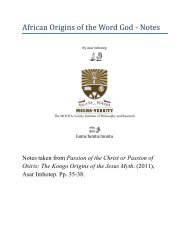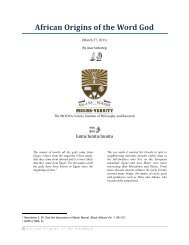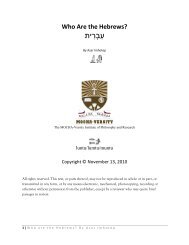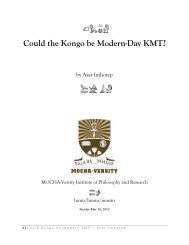reinterpretations of the ankh symbol part 2 - Asar Imhotep
reinterpretations of the ankh symbol part 2 - Asar Imhotep
reinterpretations of the ankh symbol part 2 - Asar Imhotep
You also want an ePaper? Increase the reach of your titles
YUMPU automatically turns print PDFs into web optimized ePapers that Google loves.
14<br />
In <strong>the</strong> Passion <strong>of</strong> <strong>the</strong> Christ or Passion <strong>of</strong> Osiris book, I demonstrated how linguistically <strong>the</strong> concept <strong>of</strong><br />
“life” is conveyed using terms that are based in <strong>the</strong> s/j, s-r or s-l root in many African languages<br />
(including ciKam/Egyptian) and how this is embedded in <strong>the</strong> name Wsr/Jsr (Osiris). The essence <strong>of</strong><br />
Wsr is based <strong>of</strong>f <strong>the</strong> -s- root which essentially means “to activate, <strong>the</strong> power to cause to be.” This /s/<br />
alternates with /j/. Given <strong>the</strong>se two things, I believe we can associate <strong>the</strong> Yorùbá terms Òjè “life”<br />
(after death) and èjè “blood” (êjë “vow,” blood oath?) 9 as related to our -s- root in Wsr. This root can<br />
be seen in Yorùbá Ò jé “He was/He is – He happened to be,” jí “Wake up from sleep” (back into<br />
consciousness and life). Compare with Westermann’s Proto-Niger-Congo reconstruction *za/dza<br />
“blood.” Nupe has e-dza, Guang obu-dza, Lefana ubu-dza, Ahlo obi-dza, Ewe ku-dze, Kilimonjaro<br />
(Caga) samu, sau, Sumerian sa, Yorùbá e-dze “blood.” Blood is life, <strong>the</strong> blood is soul. In Yorùbá we<br />
have sí “to be” which is cognate with Hebrew yesh “<strong>the</strong>re is” (=Assyrian su “to be, to have”). 10 We<br />
should also note that among <strong>the</strong> ancient Greeks <strong>the</strong> term zoe (s>z) is “life personified” (usually<br />
paired with logos “<strong>the</strong> word”). In Kiswahili eshe also means “life.” In <strong>part</strong> one <strong>of</strong> this series, we noted<br />
<strong>the</strong> anx sign represented a master teacher or healer and in Africa this healer is called nganga which<br />
is anx reduplicated. If <strong>the</strong> anx also was pronounced za, <strong>the</strong>n we may have ano<strong>the</strong>r correlation as a<br />
doctor or priest in Egyptian was called sA, sAw, swnw.<br />
As we can see above, blood is related to life and is captured in various cognate terms: sa, za, dza,<br />
dze, etc. The support for <strong>the</strong> association between <strong>the</strong> anx and blood comes from <strong>the</strong> thorax once<br />
again. The following image displays <strong>the</strong> blood supply to <strong>the</strong> thoracic wall.<br />
The thoracic wall is supplied by three sources <strong>of</strong> blood<br />
supply:<br />
� axillary<br />
o supreme thoracic (2)<br />
o lateral thoracic (3)<br />
� subclavian<br />
o internal thoracic (or mammary) artery<br />
(1)<br />
� anterior intercostal branches<br />
� aorta<br />
intercostal arteries (4)<br />
9 It should be noted that <strong>the</strong> word anx in Egyptian also means “oath.” This could be fur<strong>the</strong>r pro<strong>of</strong> that <strong>the</strong> anx <strong>symbol</strong><br />
could carry more than one sound value.<br />
10 This -s- root is found in <strong>the</strong> Yorùbá phrase dá wa sí “Keep us alive” (Preserve us); Kúda yi si “Death kept this one<br />
alive.” The term sí means to have “life,” to “exist;” in o<strong>the</strong>r words, “to be.”






